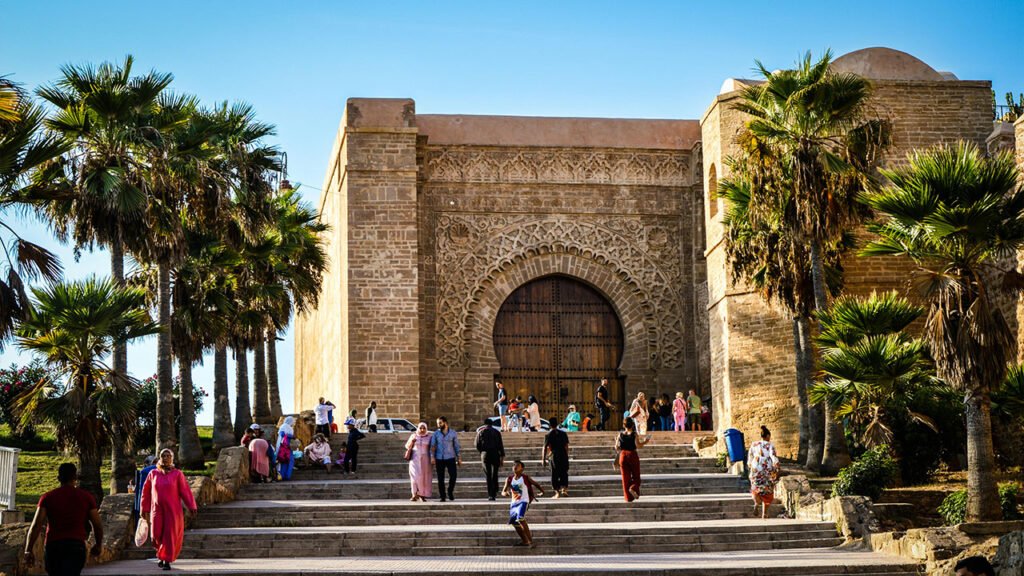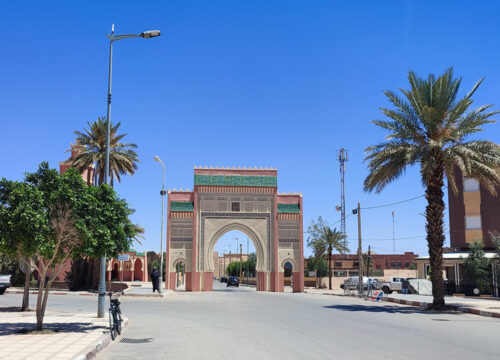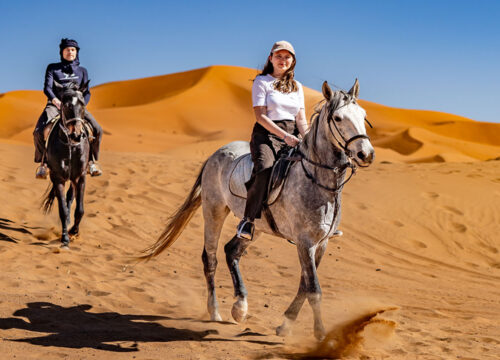THE CITY OF RABAT
Throughout the ages, Rabat has stood as a fortress of governance, cultural richness, and aesthetic grace. It is renowned for being the capital of Morocco, as well as a vital cultural and political center in the region. As the second-largest city in Morocco, Rabat is an important metropolitan area in the country. The city sprawls over an area of about 117 square kilometers in northwestern Morocco, situated on the Atlantic Ocean at the mouth of the river Bou Regreg. It is located approximately 90 km (56 mi) northeast of Casablanca, Morocco’s largest city. Historically, Morocco has seen various capitals over its long history, but the Rabat we recognize today was established in the 12th century by the Almohad ruler Abd al-Mu’min. It became a prominent political and cultural hub, especially after being designated as the capital of Morocco in the early 20th century during the French protectorate.
The city is often celebrated as ‘the city of lights and gardens’ due to its lush green spaces, expansive gardens, and significant landmarks, including the iconic Mausoleum of Mohammed V and the modern Mohammed VI Museum of Modern and Contemporary Art.
Rabat, the heart of Morocco, stands as a beacon of learning and governance, home to the esteemed Mohammed V University. This institution anchors the city’s reputation as a pivotal educational and intellectual nexus within the country. Amidst Rabat’s urban fabric, the majestic Hassan Tower soars, a testament to the city’s storied past, while the Kasbah of the Udayas, with its hues and strategic location, narrates tales of ancient times and cultural exchange. As the seat of Morocco’s government, Rabat pulsates with political and economic vitality, orchestrating the nation’s affairs from its historic and contemporary halls.
Rabat is a pivotal center for Moroccan media, including film and music production, and boasts a variety of cultural centers, museums, artistic institutes, sports clubs, and universities. The climate in Rabat offers a pleasant contrast with mild winters and warm summers, making the city an attractive destination year-round. With a population of over 1.2 million residents, Rabat balances the vibrancy of city life with the tranquility of its coastal and green spaces, providing a lively yet serene environment.

WHAT DOES RABAT CONTAIN?
The city is renowned for hosting an array of historical sites and architectural marvels, including the majestic Kasbah of the Udayas, a UNESCO World Heritage Site that offers a glimpse into Morocco’s rich history. Rabat is also home to the Hassan Tower, an iconic minaret of an incomplete mosque that dates back to the end of the 12th century, and the Mausoleum of Mohammed V, which houses the tombs of the Moroccan king and his two sons. The city’s strategic location along the Atlantic coast has been pivotal throughout history, notably as a base for expeditions during the Almohad Caliphate in the 12th century.
Rabat’s storied history began in earnest with its establishment as a fortress by the Almohads in the 12th century, transforming it into a fortified monastery, or ribat, which is where the city gets its name. Over the centuries, Rabat has witnessed the rise and fall of empires, serving as a pivotal political and cultural center. In the 17th century, it became a haven for Andalusian refugees, enriching its cultural and architectural heritage.
The true transformation of Rabat into a modern capital began in the early 20th century under the French Protectorate, which designated it as the administrative capital. The city was significantly modernized, yet it retained its historical character through the preservation of its ancient sites.
Among Rabat’s most enchanting sights is the Chellah, an ancient Roman ruin that was later transformed into a royal necropolis by the Merinid dynasty. This site exemplifies the layers of history that characterize the city. The modern era has seen Rabat’s emergence as a cultural hub, highlighted by the Mohammed VI Museum of Modern and Contemporary Art, which showcases Morocco’s artistic achievements.
Rabat is brimming with fascinating tourist attractions, so if you’re eager to witness the splendor of Morocco’s capital, explore our Rabat day tours. For those not in Morocco but wishing to experience the allure of this historic land, our Morocco tour packages offer a range of options to discover Rabat and beyond.
Q- Is Rabat safe to visit?
A- There is generally no advisory against travel to Rabat, the capital city of Morocco. Rabat is considered safe for tourists, including the surrounding areas such as Sale and the coastal regions. The city is known for its low crime rate compared to other major cities.
Q- What is the best time to visit Rabat?
A- The best times to visit Rabat are during the spring (April to June) and fall (September to October). These periods offer pleasant weather, fewer crowds, and often more affordable accommodation prices.
Q- What city are the Hassan Tower and the Mausoleum of Mohammed V in?
A- Rabat. Both the Hassan Tower and the Mausoleum of Mohammed V are significant landmarks located in Rabat. These sites are emblematic of the city’s rich history and architectural beauty.
Q- What is there to do in Rabat in 2 days?
A- Visiting the Hassan Tower and the Mausoleum of Mohammed V, exploring the Kasbah of the Udayas, relaxing in the Andalusian Gardens, walking along the Bouregreg Marina, and browsing the markets in the Medina. Additionally, the Chellah Necropolis and the Contemporary Art Museum are must-visit places.
Q- How much does a trip to Rabat cost?
A- A guided tour of Rabat’s main attractions, including the Hassan Tower, Mausoleum of Mohammed V, and the Kasbah, typically costs around $50 to $70 per person. Prices may vary depending on the inclusion of meals and transportation.
Q- Where is best to stay in Morocco to see historical sites?
A- Staying in Rabat can offer visitors a mix of historical sites, such as the Hassan Tower, Mausoleum of Mohammed V, and the Kasbah of the Udayas. The city center provides various accommodations ranging from luxury hotels to budget-friendly options, all within close proximity to major attractions.
Q- How should I dress in Rabat?
A- While Morocco is a liberal country, modest dress is recommended. Loose fitting pants, long skirts, and covered shoulders are appropriate for both men and women. Considering Rabat’s coastal climate, lightweight and breathable fabrics are advisable.
Q- Is visiting other cities like Marrakech and Fes worth it?
A- Yes, each Moroccan city offers a unique experience. Marrakech is known for its bustling souks and Jemaa el-Fnaa square, while Fes is famed for its historic medina and traditional crafts. Visiting these cities provides a broader perspective on Morocco’s diverse cultural heritage.






